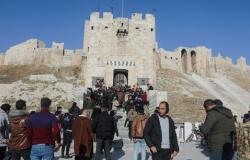A large delegation of British investors visited Dakhla on Tuesday July 18 and Wednesday July 19 to explore investment opportunities in the region. This visit follows a conference organized at the beginning of November last in London, at the initiative of the Moroccan Embassy in the United Kingdom.
In a statement to the media, the head of the British delegation, Oblin Group Chairman and CEO Brannan Tempest hinted that his group intends to invest up to $100 billion in the southern provinces. The announcement, confirmed by a press release, raises legitimate questions as to the nature of this huge investment.
“The amount of 100 billion dollars includes a series of projects planned in several provinces, in particular in Dakhla and Laâyoune, which will be carried out in several phases.“, Specifies a source close to the Oblin group, contacted by The360.
This is the second visit to Morocco in six months by the CEO of the British group. Brannan Tempest is among the personalities who took part in the 27th meeting of the partners of the international network Dii Desert Energy, organized in partnership with Nareva, on February 9 and 10 in Dakhla.
Oblin Group CEO Brannan Tempest at the 27th Dii Desert Energy International Network Partners Meeting on February 9, 2023 in Dakhla.
The Oblin Group has been active in the renewable energy sector for over 15 years, specializing in open water hydropower (FSEC), solar PV and energy storage solutions. It has several subsidiaries in its fold: OblinCEA, OblinEngine, Oblin Green, Oblin Energy, OblinArk. The group also holds three patents in renewable energies.
The projects planned in the southern provinces, adds our interlocutor, will be overseen by the OblinCEA subsidiary, which specializes in the engineering, supply and construction of photovoltaic solar systems and wind turbines. “A new company, OblinCEA, was formed and officially launched on August 1, 2022. Based in Laayoune, OblinCEA will play a key role in the Oblin Green project, the first phase of which is expected to start in 2023“, we read on the site of the subsidiary of the British group.
OblinCEA has already carried out renewable energy projects in Southeast Asia, particularly in Thailand and, most recently, in Vietnam where it built two large wind farms.
Read also: British investors prospecting in Dakhla, a megaproject already planned
With regard to Dakhla, the British firm plans to launch around twenty projects on a total area of 200,000 hectares, for a total amount of 28 billion dollars. These projects cover:
– 2.4 GW to 6 GW solar panel assembly plant per year: 500 million dollars and 550 jobs.
– Green hydrogen/green ammonia synthesis: 4.4 billion dollars and 250 jobs.
– Installation of seawater desalination from 5,000 to 10,000 m2: 68 million dollars and 36 jobs.
– Solar photovoltaic and wind power plant with energy storage: 13 billion dollars and 1,200 jobs.
– Green glass manufacturing plant: 145 million dollars and 168 jobs.
– Lithium battery manufacturing plant: 850 million dollars and 550 jobs.
– Manufacture of wind turbine blades and masts on site: 870 million dollars and 385 jobs.
– Lithium battery production plant: 7.4 billion dollars and 250 jobs.
Overview of Oblin Group projects in the Dakhla region.
An identical amount, i.e. 28 billion dirhams, is scheduled for around twenty other projects in Laâyoune, in the municipality of El Marsa:
– Solar panel factory: 500 million dollars and 550 jobs.
– New deep water port capable of handling ISO containers and bulk green hydrogen/green ammonia: $690 million and 56 jobs.
– Green hydrogen/green ammonia synthesis: 4.4 billion dollars and 250 jobs.
– Installation of seawater desalination from 5,000 to 10,000 m2: 68 million dollars and 36 jobs.
– Solar photovoltaic and wind power plant with energy storage: 13 billion dollars and 1,200 jobs.
– Green glass manufacturing plant: 145 million dollars and 168 jobs.
– Lithium battery manufacturing plant: 850 million dollars and 550 jobs.
– Manufacture of wind turbine blades and masts on site: 870 million dollars and 385 jobs.
– Lithium battery production plant: 7.4 billion dollars and 250 jobs.

Overview of the Oblin group’s projects in Laâyoune.
The promoters of the Oblin project highlight the importance of local industrial integration. “The solar panels will be built in Morocco, without depending on imports from China and Southeast Asia“, insists our interlocutor. Better, he adds, the land needs of the project are of a similar scale to those of the Xlinks project (150,000 hectares) but Oblin Green produces five times the energy promised by the Xlinks startup.
On the financing side, The360 learned that contacts have been established with the Crédit Agricole group in Morocco, which would have liked to enter into a consortium with other local banks. The Oblin group ensures that its project is attracting the interest of investors from the United States, Canada, Asia and Oceania, and says it is open to any other financing option (equity contribution, debt, etc.).
Finally, it should be noted that these projects are still at the intention stage, like the other megaprojects announced in recent months by the world giants of renewable energies (Total Eren, Xlinks, CWP, Adani, etc.). Their realization will depend on the negotiations in progress (or to come) with the Moroccan authorities.








